Abstract
Continuous monitoring of brainstem auditory evoked potentials (BAEPs) was carried out in 57 comatose patients for periods ranging from 5 hours to 13 days. In 53 cases intracranial pressure (ICP) was also simultaneously monitored. The study of relative changes of evoked potentials over time proved more relevant to prognosis than the mere consideration of "statistical normality" of waveforms; thus progressive degradation of the BAEPs was associated with a bad outcome even if the responses remained within normal limits. Contrary to previous reports, a normal BAEP obtained during the second week of coma did not necessarily indicate a good vital outcome; it could, however, do so in cases with a low probability of secondary insults. The simultaneous study of BAEPs and ICP showed that apparently significant (greater than 40 mm Hg) acute rises in ICP were not always followed by BAEP changes. The stability of BAEP's despite "significant" ICP rises was associated in our patients with a high probability of survival, while prolongation of central latency of BAEPs in response to ICP modifications was almost invariably followed by brain death. Continuous monitoring of brainstem responses provided a useful physiological counterpart to physical parameters such as ICP. Serial recording of cortical EPs should be added to BAEP monitoring to permit the early detection of rostrocaudal deterioration.
Full text
PDF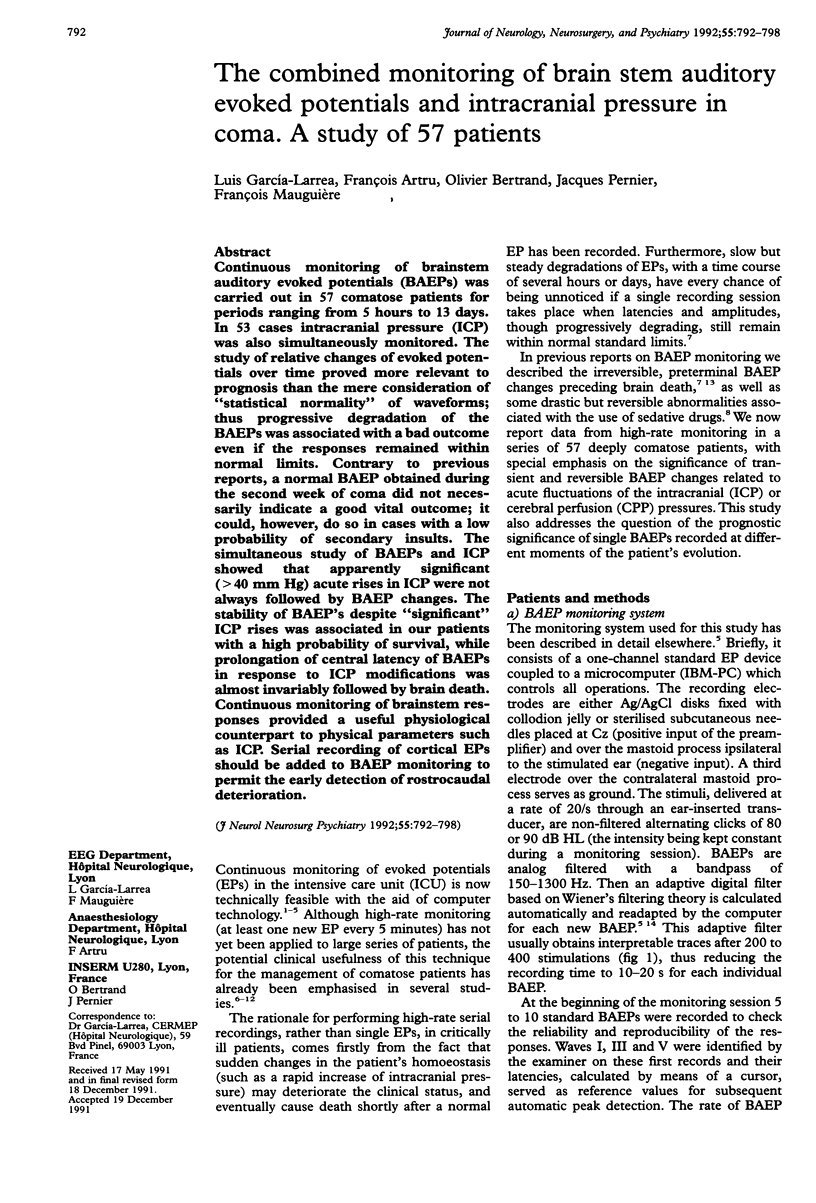
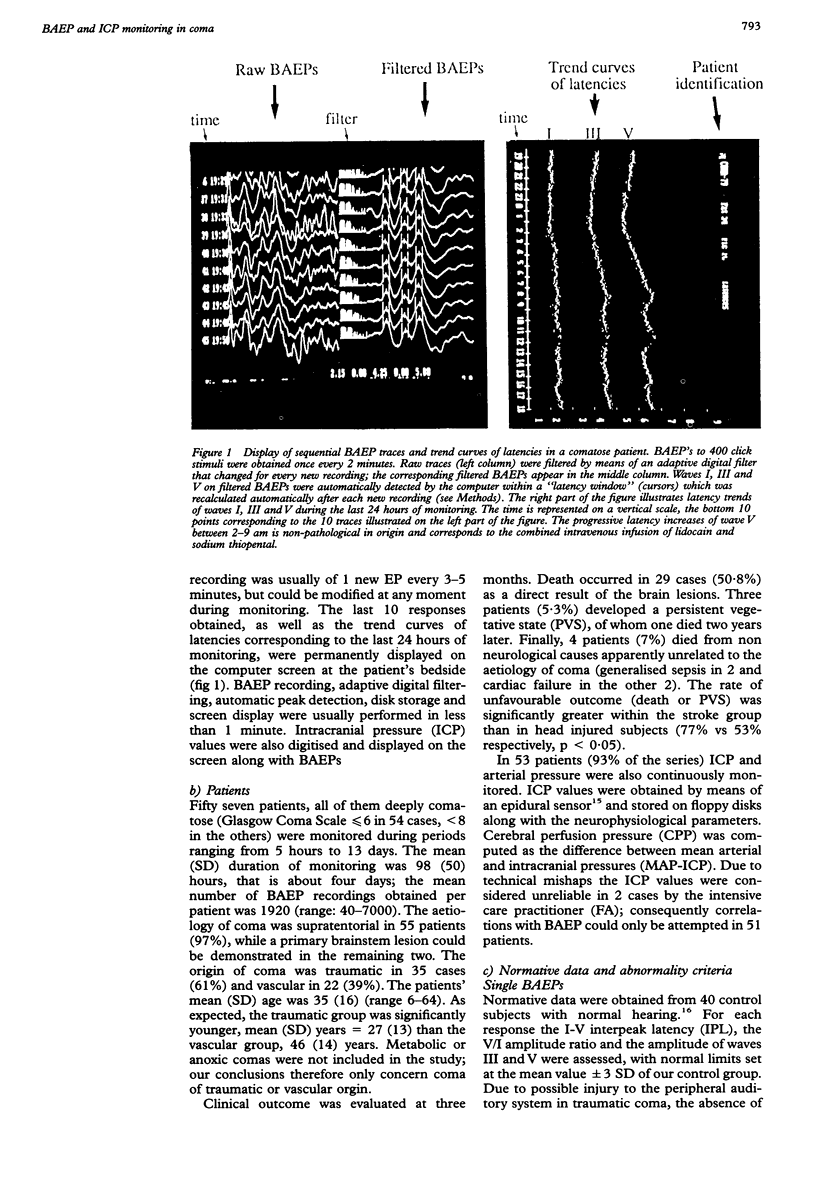
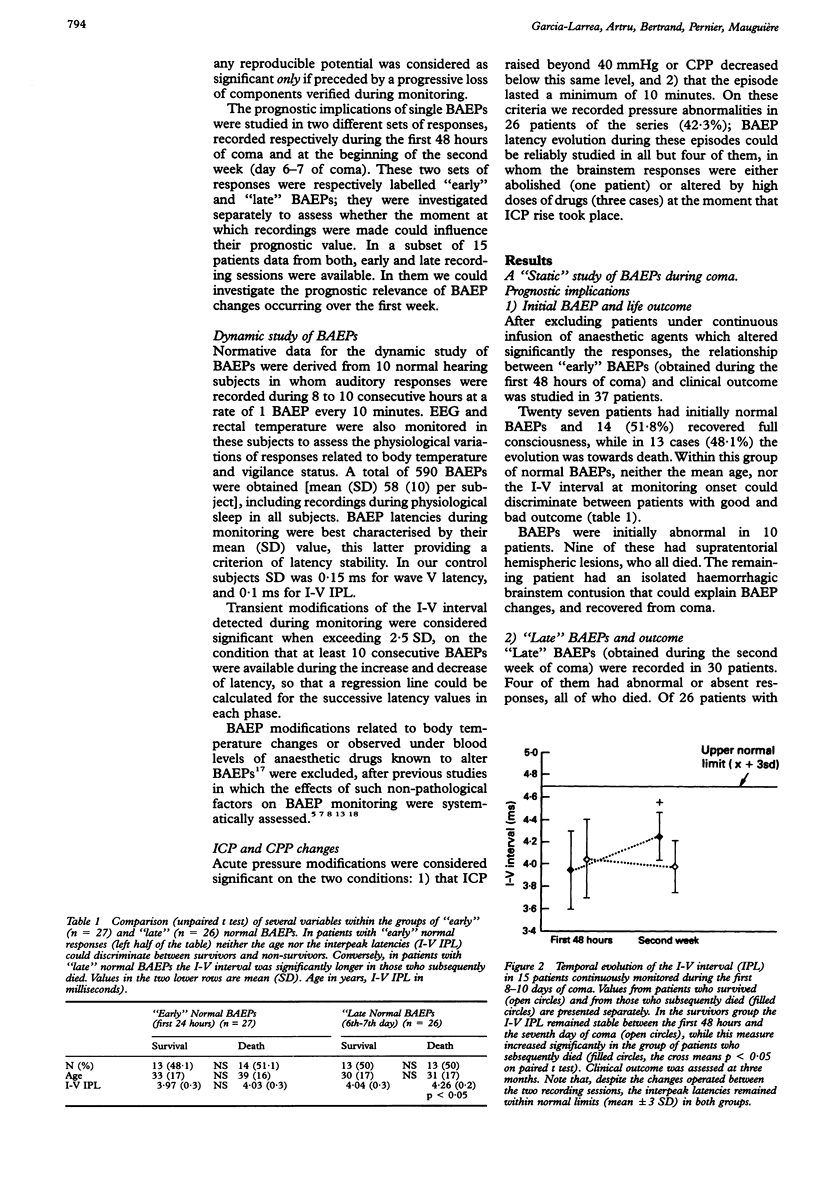
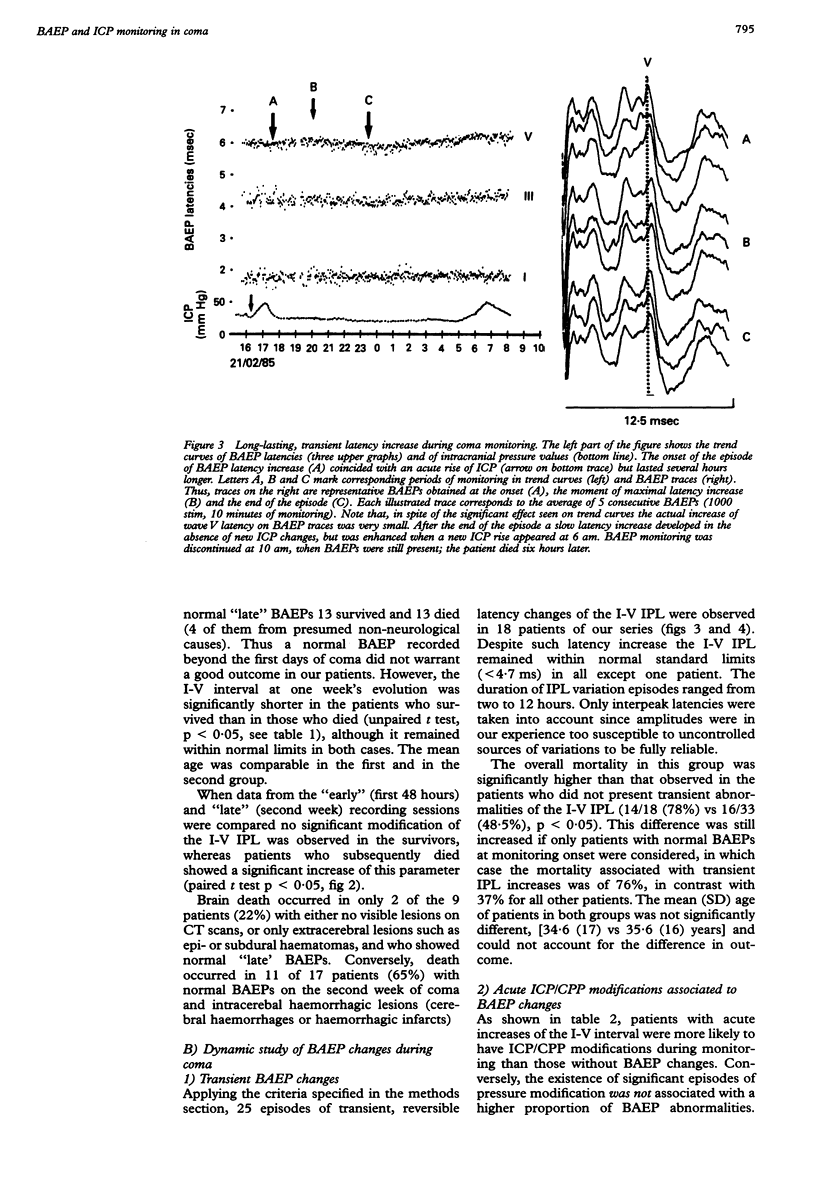

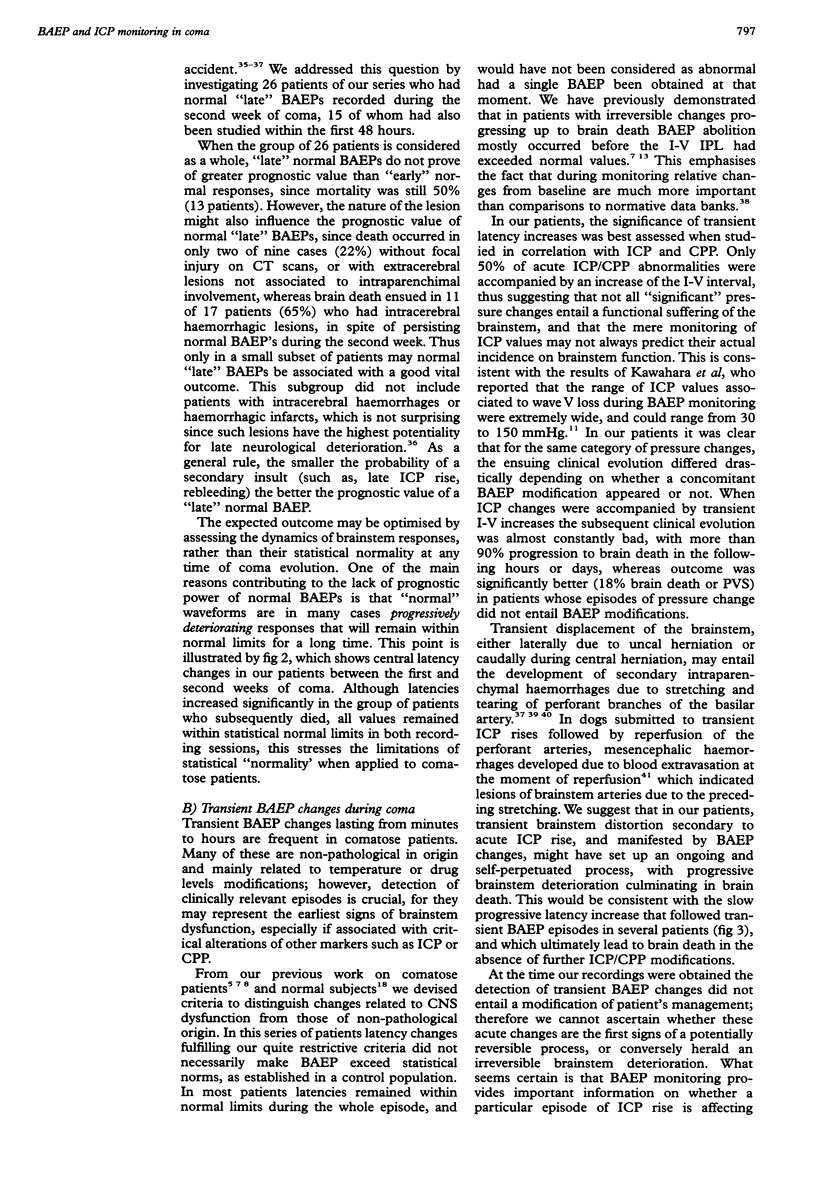

Images in this article
Selected References
These references are in PubMed. This may not be the complete list of references from this article.
- Bastuji H., Garcia Larrea L., Bertrand O., Mauguière F. BAEP latency changes during nocturnal sleep are not correlated with sleep stages but with body temperature variations. Electroencephalogr Clin Neurophysiol. 1988 Jul;70(1):9–15. doi: 10.1016/0013-4694(88)90189-7. [DOI] [PubMed] [Google Scholar]
- Bertrand O., Garcia-Larrea L., Artru F., Mauguière F., Pernier J. Brain-stem monitoring. I. A system for high-rate sequential BAEP recording and feature extraction. Electroencephalogr Clin Neurophysiol. 1987 Nov;68(6):433–445. doi: 10.1016/0168-5597(87)90055-4. [DOI] [PubMed] [Google Scholar]
- Boston J. R., Deneault L. G. Sensory evoked potentials: a system for clinical testing and patient monitoring. Int J Clin Monit Comput. 1984;1(1):13–19. doi: 10.1007/BF01726657. [DOI] [PubMed] [Google Scholar]
- Buchner H., Ferbert A., Hacke W. Serial recording of median nerve stimulated subcortical somatosensory evoked potentials (SEPs) in developing brain death. Electroencephalogr Clin Neurophysiol. 1988 Jan;69(1):14–23. doi: 10.1016/0013-4694(88)90031-4. [DOI] [PubMed] [Google Scholar]
- Cant B. R., Hume A. L., Judson J. A., Shaw N. A. The assessment of severe head injury by short-latency somatosensory and brain-stem auditory evoked potentials. Electroencephalogr Clin Neurophysiol. 1986 May;65(3):188–195. doi: 10.1016/0168-5597(86)90053-5. [DOI] [PubMed] [Google Scholar]
- Carlsson C. A., von Essen C., Löfgren J. Factors affecting the clinical corse of patients with severe head injuries. 1. Influence of biological factors. 2. Significance of posttraumatic coma. J Neurosurg. 1968 Sep;29(3):242–251. doi: 10.3171/jns.1968.29.3.0242. [DOI] [PubMed] [Google Scholar]
- Clifton G. L., Grossman R. G., Makela M. E., Miner M. E., Handel S., Sadhu V. Neurological course and correlated computerized tomography findings after severe closed head injury. J Neurosurg. 1980 May;52(5):611–624. doi: 10.3171/jns.1980.52.5.0611. [DOI] [PubMed] [Google Scholar]
- Facco E., Martini A., Zuccarello M., Agnoletto M., Giron G. P. Is the auditory brain-stem response (ABR) effective in the assessment of post-traumatic coma? Electroencephalogr Clin Neurophysiol. 1985 Sep;62(5):332–337. doi: 10.1016/0168-5597(85)90041-3. [DOI] [PubMed] [Google Scholar]
- Ferbert A., Buchner H., Brückmann H., Zeumer H., Hacke W. Evoked potentials in basilar artery thrombosis: correlation with clinical and angiographic findings. Electroencephalogr Clin Neurophysiol. 1988 Feb;69(2):136–147. doi: 10.1016/0013-4694(88)90209-x. [DOI] [PubMed] [Google Scholar]
- Garcia-Larrea L., Bertrand O., Artru F., Pernier J., Mauguière F. Brain-stem monitoring. II. Preterminal BAEP changes observed until brain death in deeply comatose patients. Electroencephalogr Clin Neurophysiol. 1987 Nov;68(6):446–457. doi: 10.1016/0168-5597(87)90056-6. [DOI] [PubMed] [Google Scholar]
- García-Larrea L., Artru F., Bertrand O., Pernier J., Mauguière F. Transient drug-induced abolition of BAEPs in coma. Neurology. 1988 Sep;38(9):1487–1489. doi: 10.1212/wnl.38.9.1487. [DOI] [PubMed] [Google Scholar]
- Greenberg R. P., Becker D. P., Miller J. D., Mayer D. J. Evaluation of brain function in severe human head trauma with multimodality evoked potentials. Part 2: Localization of brain dysfunction and correlation with posttraumatic neurological conditions. J Neurosurg. 1977 Aug;47(2):163–177. doi: 10.3171/jns.1977.47.2.0163. [DOI] [PubMed] [Google Scholar]
- Hacke W. Neuromonitoring. J Neurol. 1985;232(3):125–133. doi: 10.1007/BF00313886. [DOI] [PubMed] [Google Scholar]
- Hassler O. Arterial pattern of human brainstem. Normal appearance and deformation in expanding supratentorial conditions. Neurology. 1967 Apr;17(4):368–passim. doi: 10.1212/wnl.17.4.368. [DOI] [PubMed] [Google Scholar]
- JOHNSON R. T., YATES P. O. Clinicopathological aspects of pressure changes at the tentorium. Acta radiol. 1956 Jul-Aug;46(1-2):242–249. doi: 10.3109/00016925609170833. [DOI] [PubMed] [Google Scholar]
- Javel E., Mouney D. F., McGee J., Walsh E. J. Auditory brainstem responses during systemic infusion of lidocaine. Arch Otolaryngol. 1982 Feb;108(2):71–76. doi: 10.1001/archotol.1982.00790500007002. [DOI] [PubMed] [Google Scholar]
- Kaga K., Nagai T., Takamori A., Marsh R. R. Auditory short, middle, and long latency responses in acutely comatose patients. Laryngoscope. 1985 Mar;95(3):321–325. doi: 10.1288/00005537-198503000-00017. [DOI] [PubMed] [Google Scholar]
- Karnaze D. S., Weiner J. M., Marshall L. F. Auditory evoked potentials in coma after closed head injury: a clinical-neurophysiologic coma scale for predicting outcome. Neurology. 1985 Aug;35(8):1122–1126. doi: 10.1212/wnl.35.8.1122. [DOI] [PubMed] [Google Scholar]
- Kawahara N., Sasaki M., Mii K., Tsuzuki M., Takakura K. Sequential changes of auditory brain stem responses in relation to intracranial and cerebral perfusion pressure and initiation of secondary brain stem damage. Acta Neurochir (Wien) 1989;100(3-4):142–149. doi: 10.1007/BF01403602. [DOI] [PubMed] [Google Scholar]
- Klintworth G. K. Paratentorial Grooving of Human Brains with Particular Reference to Transtentorial Herniation and the Pathogenesis of Secondary Brain-stem Hemorrhages. Am J Pathol. 1968 Sep;53(3):391–408. [PMC free article] [PubMed] [Google Scholar]
- Litscher G., Friehs G., Maresch H., Pfurtscheller G. Electroencephalographic and evoked potential monitoring in the hyperbaric environment. J Clin Monit. 1990 Jan;6(1):10–17. doi: 10.1007/BF02832177. [DOI] [PubMed] [Google Scholar]
- Lütschg J., Pfenninger J., Ludin H. P., Vassella F. Brain-stem auditory evoked potentials and early somatosensory evoked potentials in neurointensively treated comatose children. Am J Dis Child. 1983 May;137(5):421–426. doi: 10.1001/archpedi.1983.02140310003001. [DOI] [PubMed] [Google Scholar]
- Maresch H., Pfurtscheller G. Simultaneous measurement of auditory brain stem potentials and EEG spectra. Electroencephalogr Clin Neurophysiol. 1983 Nov;56(5):531–533. doi: 10.1016/0013-4694(83)90239-0. [DOI] [PubMed] [Google Scholar]
- Maynard D. E., Jenkinson J. L. The cerebral function analysing monitor. Initial clinical experience, application and further development. Anaesthesia. 1984 Jul;39(7):678–690. doi: 10.1111/j.1365-2044.1984.tb06477.x. [DOI] [PubMed] [Google Scholar]
- Pfurtscheller G., Schwarz G., Schroettner O., Litscher G., Maresch H., Auer L., List W. Continuous and simultaneous monitoring of EEG spectra and brainstem auditory and somatosensory evoked potentials in the intensive care unit and the operating room. J Clin Neurophysiol. 1987 Oct;4(4):389–396. doi: 10.1097/00004691-198710000-00004. [DOI] [PubMed] [Google Scholar]
- Seales D. M., Rossiter V. S., Weinstein M. E. Brainstem auditory evoked responses in patients comatose as a result of blunt head trauma. J Trauma. 1979 May;19(5):347–353. doi: 10.1097/00005373-197905000-00008. [DOI] [PubMed] [Google Scholar]
- Tsubokawa T., Nishimoto H., Yamamoto T., Kitamura M., Katayama Y., Moriyasu N. Assessment of brainstem damage by the auditory brainstem response in acute severe head injury. J Neurol Neurosurg Psychiatry. 1980 Nov;43(11):1005–1011. doi: 10.1136/jnnp.43.11.1005. [DOI] [PMC free article] [PubMed] [Google Scholar]
- de Rougemont J., Barge M., Benabid A. L. Un nouveau capteur pour la mesure de la pression intra-crânienne. Valeur de la dure-mère en tant que membrane susceptible de transmettre les pressions. Neurochirurgie. 1971 Dec;17(7):579–590. [PubMed] [Google Scholar]
- de Weerd A. W., Groeneveld C. The use of evoked potentials in the management of patients with severe cerebral trauma. Acta Neurol Scand. 1985 Nov;72(5):489–494. doi: 10.1111/j.1600-0404.1985.tb00906.x. [DOI] [PubMed] [Google Scholar]



